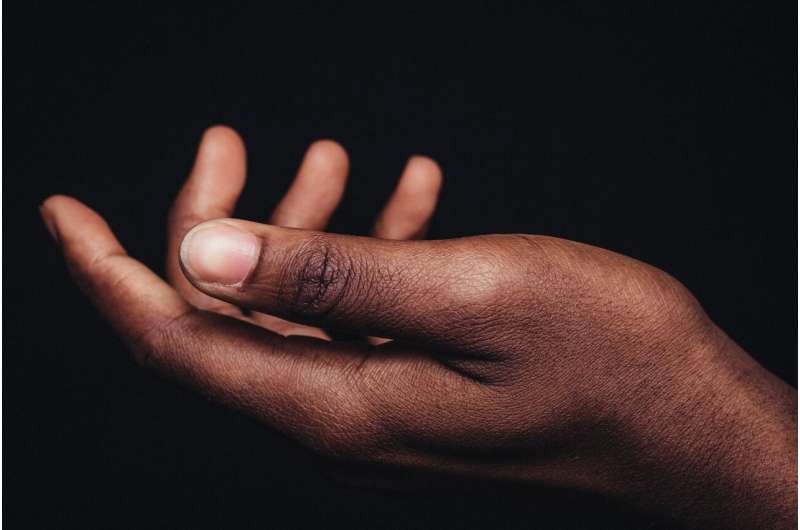This article has been reviewed according to Science X's editorial process and policies. Editors have highlighted the following attributes while ensuring the content's credibility:
fact-checked
peer-reviewed publication
trusted source
proofread
Nonsurgical treatment of thumb arthritis shows lasting benefits

Initial nonsurgical treatment, including the use of orthotics and exercise therapy, provides satisfactory long-term outcomes for patients with osteoarthritis of the thumb carpometacarpal joint (CMC-1 OA), with a low rate of conversion to surgery, reports a study in the Journal of Bone and Joint Surgery.
"Our findings support nonsurgical treatment as the first treatment choice and suggest that treatment effects are sustainable," in patients with CMC-1 OA, according to the new research by Lisa Esteban Lopez, LMJ, MSc, PT, of University Medical Center Rotterdam, the Netherlands.
New data on long-term outcomes of nonsurgical therapy for thumb osteoarthritis
Osteoarthritis of CMC-1 is a common condition in older adults, causing pain and stiffness at the base of the thumb. Current guidelines call for initial nonsurgical treatments, such as orthoses, steroid injections, analgesics, and exercise therapy. Surgery can be considered if the results of nonsurgical treatment are inadequate, but is associated with high costs, a lengthy rehabilitation period, and variable outcomes.
Previous studies have documented the short-term effectiveness—up to one year—of nonsurgical treatment for CMC-1 OA. However, few studies have examined the longer-term outcomes, including how many patients will eventually undergo surgery.
To address this evidence gap, Ms. Esteban Lopez and colleagues analyzed long-term follow-up data for patients with CMC-1 OA treated at eight specialized hand clinics between 2011 and 2015. The study excluded patients with arthritis due to trauma, other hand conditions, or previous corticosteroid injections.
Nonsurgical treatment focused on the use of orthotics, physical therapy sessions focused on exercises and achieving more stable thumb opposition, and daily home exercise. With use of the standardized Michigan Hand Questionnaire (MHQ), the researchers analyzed pain, activities of daily living (ADL), and other outcomes at long-term follow-up (greater than five years).
Thumb pain and function remain stable more than five years after treatment
Initial analysis included 134 patients who did not undergo surgery. In this group, long-term follow-up showed no significant change in scores for pain or limitations in ADL from 12 months to over five years. Most improvement occurred in the first three months, during the initial active treatment period. From 12 months to over five years, there was "clinically relevant" improvement in total MHQ score as well as in subscales for overall hand function and workability.
On a patient satisfaction questionnaire, outcomes of nonsurgical treatment were rated excellent by 16% of patients, good by 39%, fair by 26%, moderate by 14%, and poor by 5%. Most patients (71%) said they would be willing to undergo the same treatment again under similar circumstances.
Rates of subsequent surgery for thumb arthritis were evaluated in a larger sample of 217 patients with CMC-1 OA. At a median follow-up of seven years, the overall rate of conversion to surgical treatment was 22%. Seventy percent of patients who underwent surgery did so within the first year after initial treatment.
In addition to strengthening the thenar muscles responsible for thumb movement, "Exercise therapy is aimed at using a new and more stable position of the thumb, thereby reducing joint loading and inflammation," Ms. Esteban Lopez and co-authors write. "Thus, patients learn how to prevent pain by using this position and to cope with their OA."
While the study cannot prove any causal relationship, the researchers note that it reflects routine, real-world practice in treatment of CMC-1 OA.
The findings support current recommendations for initial nonsurgical treatment for OA of the thumb, while providing new evidence that positive outcomes remain stable at long-term follow-up. Adding to previous evidence of short-term benefits, the new study shows "no worsening of pain or limitations in ADL after 12 months" in patients undergoing nonsurgical treatment.
More information: Lisa M.J. Esteban Lopez et al, Long-Term Outcomes of Nonsurgical Treatment of Thumb Carpometacarpal Osteoarthritis, Journal of Bone and Joint Surgery (2023). DOI: 10.2106/JBJS.22.01116



















